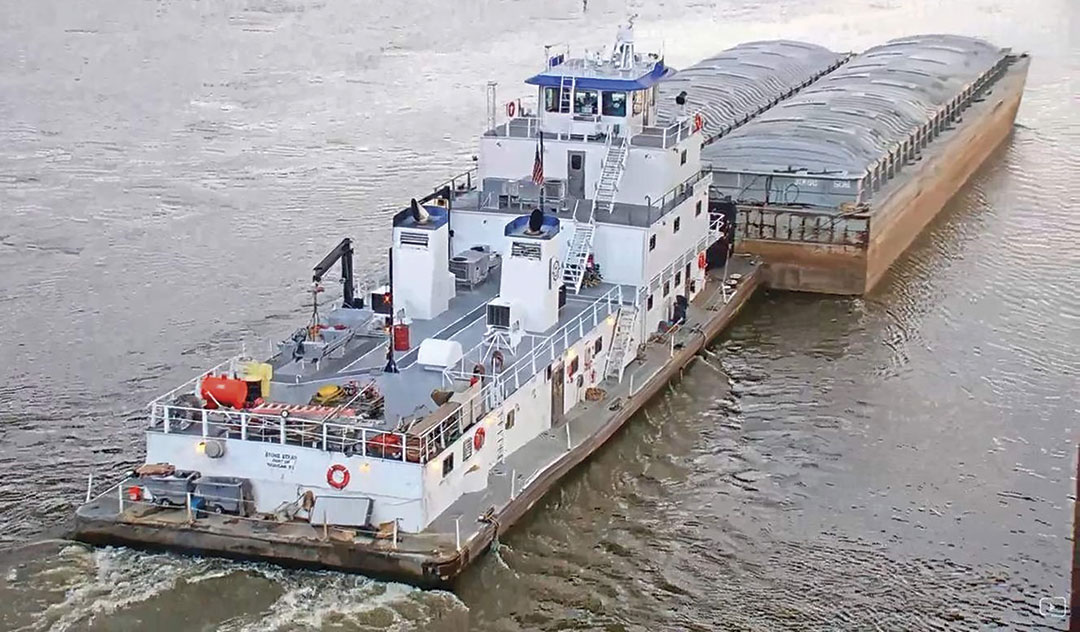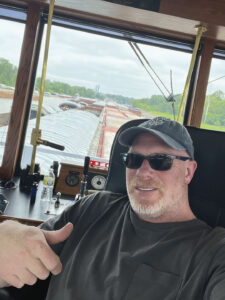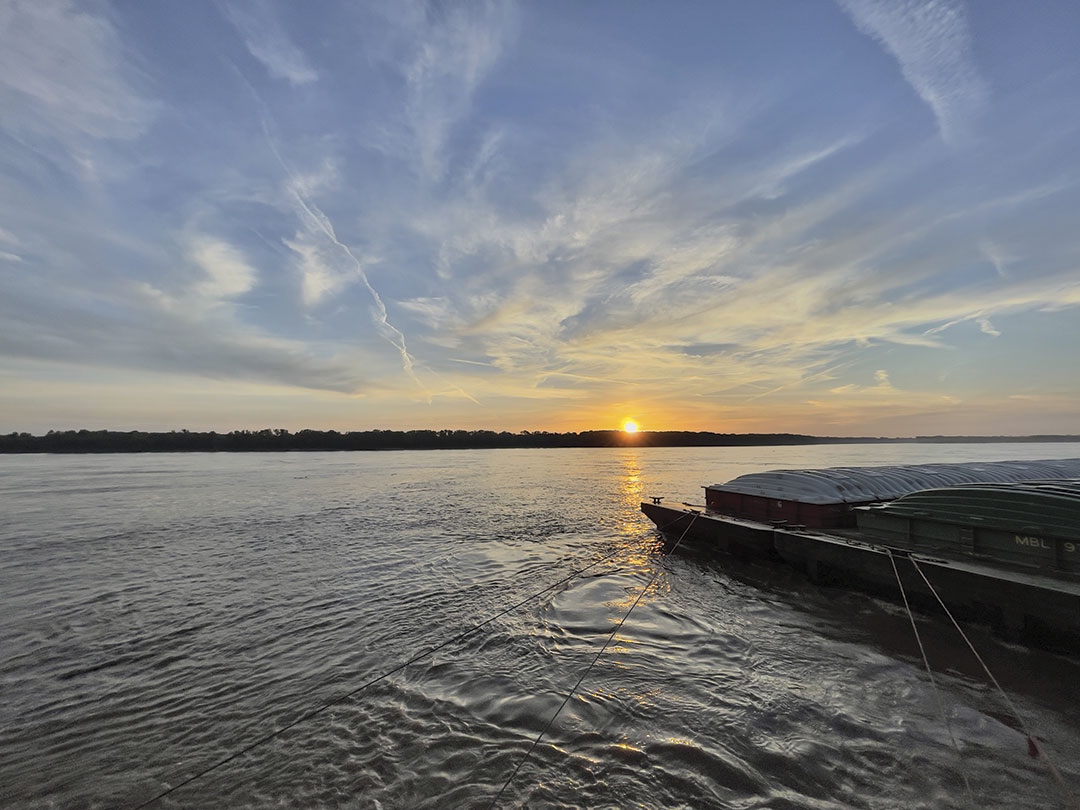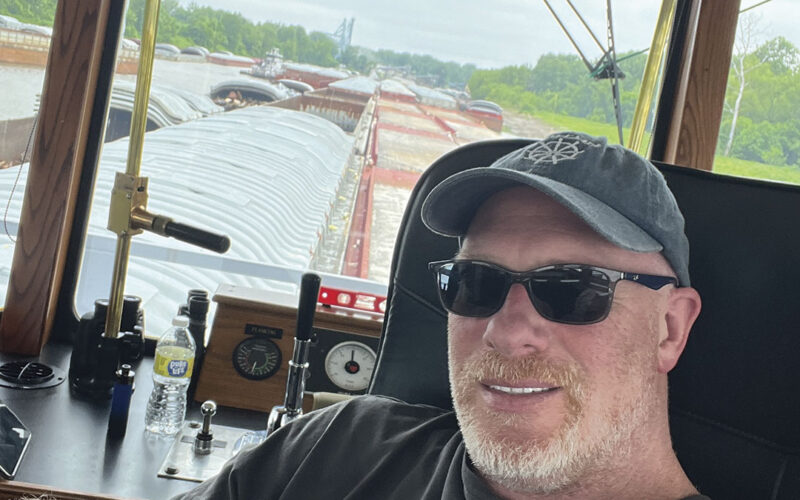

Capt. Kyle Pfenning claims he got “Mark Twained” during what he thought would be a single hitch on a towboat back in 1995. “I took the deck job just to say I’d done it,” he explained.
But a single hitch it was not to be – almost a quarter-century later, he’s veteran pilot on the inland waters.
Pfenning has guided multiple line haul boats up and down the lower and upper Mississippi and pushed a wide variety of cargoes in ever-varying configurations every mile of the river from Myrtle Grove, La., clear up to the city front of Saint Paul, Minn., more than 1,700 miles away.
Besides the Mississippi, he has piloted nearly 1,000 miles of the Ohio between its confluence with the Mississippi at Cairo, Ill., and Pittsburgh Pa.; and the 330 miles of the Illinois from Grafton, Ill. to Chicago, as well as parts of the Arkansas, Green, Verdigris, and White Rivers in low waters and high.
Over the years, Pfenning has negotiated locks thousands of times, worked in ice and fog, and seen tornadoes jump the river right in front of him.
High and low water
About the seemingly chronic low water conditions on the river, Pfenning has this perception: “It’s a ‘foreign river’ at low, low when compared to normal or high levels,” he said.
No matter where on the river he is, along with the actual soundings for his current location, he checks the Memphis Gage because it helps him predict levels where he will be as a line haul pilot in a few days. His chart plotters distinguish which channels can be used only during high water.
Although GPS and chart plotters are standard tools in a contemporary wheelhouse, a skillful pilot has to read the river without depth sounders on the lead barges because shoals and debris – like huge floating trees – could tear them off.
This skill is as important today as it was when Twain wrote his classic autobiography Life on the Mississippi.
Just as low water presents challenges, so does high water. Downbound and approaching the I-55 Bridge, he explained. “I’ve got my personal marks on that bridge, on all the bridges. It’s like running your car into the garage—I got all my marks. At low water you line up these piers, and at higher water you line up different landmarks.”
Towboats shuttling long distances up and down the river are called “line haul” boats. In contrast, “fleeting tugs” operate in specific locations or other places with shore facilities to load or discharge mostly dry bulk materials.
Line haul boats − ranging from 90 to 200 feet in length and propelled by diesel engines in the 3,000 to 11,000 horsepower range − are analogous to railroad locomotives or over-the-road, long-haul trucks.
Ironically, some of the large diesel engines, such as EMDs, are the same ones used in locomotives. Although most line haul boats have fixed wheels on shafts, some z-drive boats are now appearing on the inland rivers as well.
The standard barge size is 200 x 35 feet. A common configuration of “six strings” of five barges with a total of 30 barges equating to a tow that measures 210 feet wide by 1000 feet long. Add a 200-foot towboat to the stern of that and you’re already up to almost 1,200 feet. “That’s aircraft carrier size,” said Pfenning. By comparison, the U.S.S. Gerald R. Ford is 1,106 feet in length overall.
Fleeting tugs are designed like small line haul boats and range from 600 to 2,000 horsepower. Similar to switcher engines or freight yard tractors, fleeting tugs, which tend also to be “day boats,” have one function – to assist in assembling or disassembling tows that line haul boats shuttle up and down the river.
“It’s a milk run,” Pfenning said repeatedly. “Software updated by the captain keeps track of where we need to drop off and pick up one or more barges upbound and downbound. The tow configuration changes repeatedly. Sometimes it seems we have to stop at every stump with a rope on the river,” he added, with a chuckle. “But the software saves shuffling time when we get to the fleets.”
The VHF and U.S. Coast Guard Traffic Control add a measure of safety to the instrumentation contained in a standard wheelhouse. Southbound or downbound traffic always has priority, since these tows, made up of dozens of barges, might sweep across much of the channel as they “flank turns,” that is taking advantage of the drift to follow the channel without running aground.
A Winding Waterway
Tows on the Mississippi carry about 60 percent of U.S. grain exports with some of the largest line haul companies on the Mississippi – Ingram; ARTCo; Inland Kirby; American Commercial Barges Lines; SCF; Florida Marine; and the company that Pfenning works for, Western Rivers Boat Management (WRBM) – doing the work.
As wide as the Mississippi is in some places, it’s a crowded, winding commercial waterway with these huge tows. Nonetheless, as he says, “All these different boats and different companies cooperate to keep it safe, that means the steersmen and the Coast Guard, as well. We work all together.”
Pfenning explains that he’s not the norm as an inland waterways pilot; he’s created a unique situation for himself. His reputation for skill and flexibility led to work for several years as a “trip pilot,” someone willing and able to take the helm of any boat in any inland river at any time, season or weather.
Although he’s currently a full-time pilot with WRBM, he still works on a variety of the company’s more than 30 boats; in 2022 he worked on six different tow boats, filling in as needed. A company sometimes needs pilots who are flexible to step forward this way and run the vessel safely, no matter the conditions.
He goes on to explain it this way, “I’m not always recognized for that flexibility. Adrenaline is the part of the job I love. Having a high pressure, high-stakes job is what gives me the most satisfaction. Stress builds up on the job, but that’s also the draw, the excitement.”
Captain Pfenning understands his niche, saying he’s “part of the technology transition on the river. When I started, we navigated with paper charts and radar. Old timers calculated their speed using a stopwatch and day boards, not electronics. Shortwave radios provided a link to the office on land.”
Now computers, AIS, and chart plotters have replaced some of these old tools. “When some of this tech was in its infancy, it was unreliable and we needed the paper charts as backup,” he added. “The tech is better and the river is better, thanks to the U.S. Corps of Engineers, but with better tools comes higher expectations.”

Mississippi “is easier than some of the other things a person has to deal with in life,” according to Capt. Kyle.
Humbling Isolation
The wheelhouse is an isolated place – a reality that can be a double-edged sword – it’s great to be distraction free, but on the other hand when isolation combines with fatigue, not even all the coffee and cigars can keep the person in the wheelhouse alert.
Still, Capt. Pfenning “is living the dream” working the river. “It’s a humbling experience to work on the river and witness all the cool stuff,” he explained.
“The quiet solitude of the Mississippi River can counter a crappy mood. I enjoy the work, the people, the view, and what a view it is! Bluffs and caves, wildlife, buildings of all sorts from grain silos converted to fish camps, other traffic, weather phenomena…”
He shares all that from when he was first “Mark Twained,” but what’s clear is that, for Capt. Kyle Pfenning, being a pilot and working on the Big River “is a whole lot easier than some of the other things a person has to deal with in life.” •

